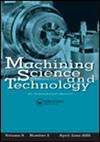Experimental study on the effect of tool parameters on the vibrational characteristic of ultrasonic vibration-assisted drilling system
IF 2.6
4区 工程技术
Q2 ENGINEERING, MANUFACTURING
引用次数: 2
Abstract
Abstract In ultrasonic vibration-assisted drilling (UVAD), the processing stability is strongly influenced by the ultrasonic vibration system's vibrational characteristics. The effect of tool parameters on UVAD's vibrational characteristic was experimentally studied and theoretically analyzed in this paper. Firstly, a measurement experiment was designed to assess the above effect in three various tools under different loads. The relationship between the ultrasonic power and amplitude was used to indirectly monitor the ultrasonic amplitude variation, which was corroborated by the UVAD test results. The ultrasonic amplitude and power were mainly controlled by the stiffness coefficient, while the damping coefficient effect could be ignored. Furthermore, the tool vibration frequency exhibited an increasing trend with the load value. Finally, the effects of the stiffness coefficient and damping coefficient on the vibrational characteristics were theoretically substantiated. The results of this study are considered instrumental in selecting tool and process parameters in ultrasonic machining.刀具参数对超声振动辅助钻井系统振动特性影响的实验研究
在超声振动辅助钻井(UVAD)中,超声振动系统的振动特性对加工稳定性有很大影响。本文对刀具参数对UVAD振动特性的影响进行了实验研究和理论分析。首先,设计了一个测量实验来评估三种不同工具在不同载荷下的上述效果。利用超声功率与振幅的关系间接监测超声振幅的变化,UVAD试验结果证实了这一点。超声振幅和功率主要由刚度系数控制,阻尼系数的影响可以忽略不计。刀具振动频率随载荷值的增大而增大。最后,从理论上验证了刚度系数和阻尼系数对振动特性的影响。研究结果对超声加工中刀具和工艺参数的选择具有指导意义。
本文章由计算机程序翻译,如有差异,请以英文原文为准。
求助全文
约1分钟内获得全文
求助全文
来源期刊

Machining Science and Technology
工程技术-材料科学:综合
CiteScore
5.70
自引率
3.70%
发文量
18
审稿时长
6 months
期刊介绍:
Machining Science and Technology publishes original scientific and technical papers and review articles on topics related to traditional and nontraditional machining processes performed on all materials—metals and advanced alloys, polymers, ceramics, composites, and biomaterials.
Topics covered include:
-machining performance of all materials, including lightweight materials-
coated and special cutting tools: design and machining performance evaluation-
predictive models for machining performance and optimization, including machining dynamics-
measurement and analysis of machined surfaces-
sustainable machining: dry, near-dry, or Minimum Quantity Lubrication (MQL) and cryogenic machining processes
precision and micro/nano machining-
design and implementation of in-process sensors for monitoring and control of machining performance-
surface integrity in machining processes, including detection and characterization of machining damage-
new and advanced abrasive machining processes: design and performance analysis-
cutting fluids and special coolants/lubricants-
nontraditional and hybrid machining processes, including EDM, ECM, laser and plasma-assisted machining, waterjet and abrasive waterjet machining
 求助内容:
求助内容: 应助结果提醒方式:
应助结果提醒方式:


